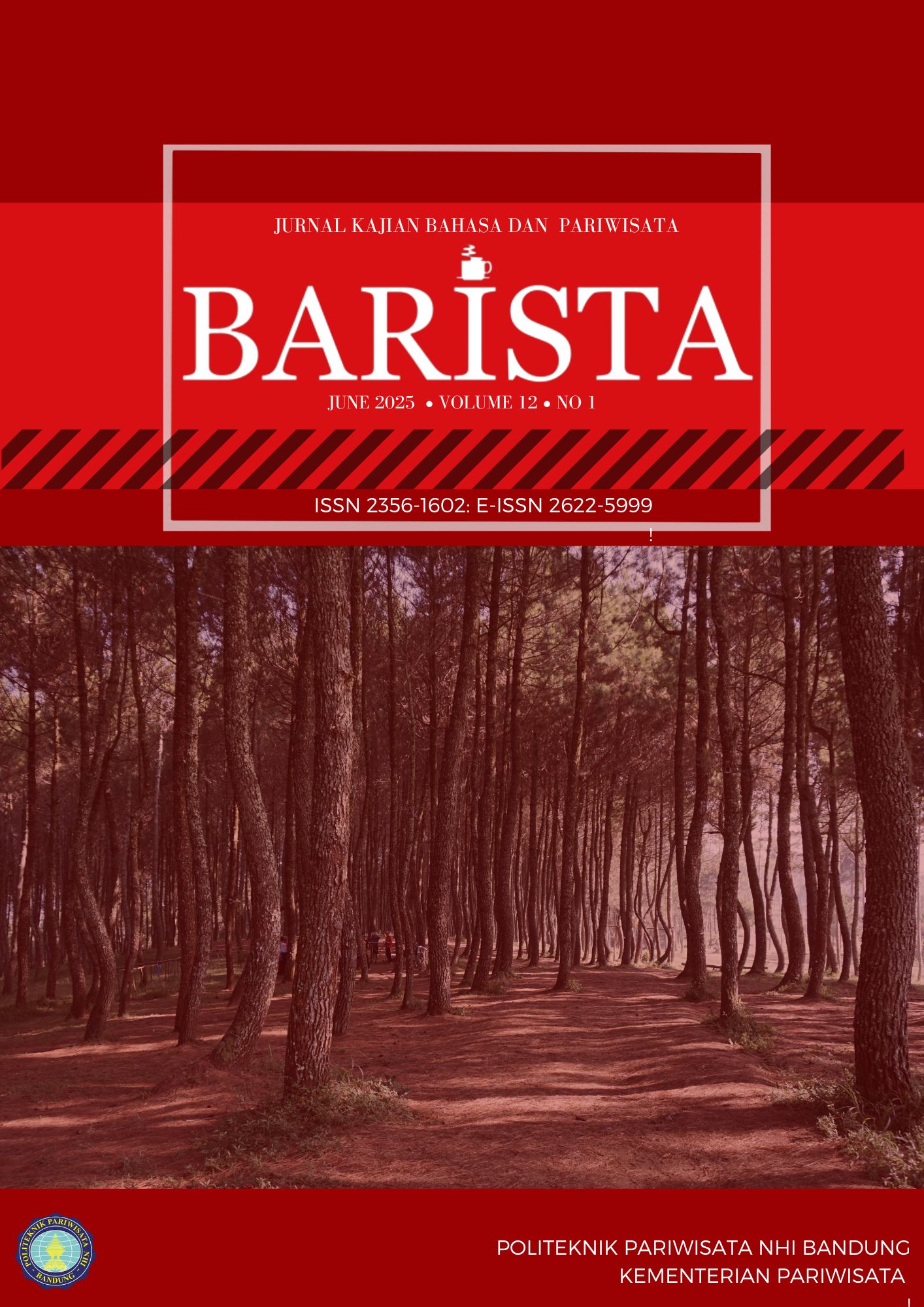The Impact Of Digital Promotion Development On Tourist Visitation Levels In Pandanrejo Village, Purworejo District, Indonesia
Main Article Content
Abstract
This study analyzes the impact of digital promotion development on tourist visitation rates in Pandanrejo Tourism Village, Purworejo Regency, by linking upstream indicators (digital activities and findings) to downstream indicators (verified visits). The empirical background shows a “surge–plateau–correction” pattern in visitation data: the annual total rose drastically from 1,661 (2020) to 8,067 (2021), remained relatively stable at 8,094 (2022), and then corrected to 4,672 (2023); monthly dynamics were prominent in March 2023 (1,766) and November 2023 (716), indicating a dependence on moments/events as the main driver. Conceptually, the study positions digital promotion (social media, SEO/local search, online reviews, UGC, and OTA channels) as a stimulus that works through the mediators of destination image, trust, and visit intention before it manifests into visits. . The proposed methodology is a mixed-methods explanatory sequential: (i) quantitative quasi-experimental through Interrupted Time Series (ITS) and multi-period Difference-in-Differences (DiD) (with similar comparison villages), as well as transfer function/ARIMAX to include digital indicators as leading indicators; (ii) PLS-SEM survey to test the image–trust–intention→visit mechanism path. Descriptive results indicate that the 2021–2022 increase is in line with the possible activation of digital promotions, while the 2023 correction suggests a weakening of upstream drivers and/or the influence of external factors (access, weather, event calendar). Practical implications include orchestrating a content calendar 6–8 weeks before the “anchor moment” (e.g., March/November), strengthening Google Business Profile (photos, FAQs, booking links), activating curated UGC, and measurement by design with upstream–downstream KPIs (reach/engagement/CTR/sentiment → tickets/parking, activity participation, homestay occupancy) and cost per visit. The study’s contribution lies in operationalizing a causal measurement framework in the context of tourism villages, which has been underrepresented. Key limitations, the lack of integration of digital-to-visit data and the absence of verified comparators are set as further agendas to ensure causal attribution, assess heterogeneity of impact across segments, and optimize promotional cost efficiency.
Article Details

This work is licensed under a Creative Commons Attribution-ShareAlike 4.0 International License.
Authors who publish with this journal agree to the following terms:
- Authors retain copyright and grant the journal right of first publication with the work simultaneously licensed under a Creative Commons Attribution License by SA that allows others to share the work with an acknowledgment of the work's authorship and initial publication in this journal.
- Authors are able to enter into separate, additional contractual arrangements for the non-exclusive distribution of the journal's published version of the work (e.g., post it to an institutional repository or publish it in a book), with an acknowledgment of its initial publication in this journal.
- Authors are permitted and encouraged to post their work online (e.g., in institutional repositories or on their website) prior to and during the submission process, as it can lead to productive exchanges, as well as earlier and greater citation of published work (See The Effect of Open Access).
References
Afshardoost, M., & Eshaghi, M. S. (2020). Destination image and tourist behavioural intentions: A meta-analysis. Tourism Management, 81, 104154. https://doi.org/10.1016/j.tourman.2020.104154
Blanco-Moreno, S., González-Fernández, A. M., Muñoz-Gallego, P. A., & Casaló, L. V. (2024). Understanding engagement with Instagram posts about tourism destinations. Journal of Destination Marketing & Management, 34, 100948. https://doi.org/10.1016/j.jdmm.2024.100948
Callaway, B., & Sant’Anna, P. H. C. (2021). Difference-in-differences with multiple time periods. Journal of Econometrics, 225(2), 200–230. https://doi.org/10.1016/j.jeconom.2020.12.001
Chen, T., Feng, W., Hong, Y., & Xu, X. (2022). The impact of online reviews on consumers’ purchasing decisions: Evidence from an eye-tracking study. Frontiers in Psychology, 13, 865702. https://doi.org/10.3389/fpsyg.2022.865702
De Luca, M., Habibi, F., & Hernández-Maskivker, G. (2024). Google Trends and transfer function models to predict tourism demand. Journal of Tourism Futures. https://doi.org/10.1108/JTF-01-2023-0018
Hair, J. F., Hult, G. T. M., Ringle, C. M., & Sarstedt, M. (2022). A primer on partial least squares structural equation modeling (PLS-SEM) (3rd ed.). SAGE.
Henseler, J., Ringle, C. M., & Sarstedt, M. (2015). A new criterion for assessing discriminant validity in variance-based structural equation modeling. Journal of the Academy of Marketing Science, 43(1), 115–135. https://doi.org/10.1007/s11747-014-0403-8
Li, H., Hu, M., & Li, G. (2020). Forecasting tourism demand with multisource big data. Annals of Tourism Research, 83, 102912. https://doi.org/10.1016/j.annals.2020.102912
Li, H., Zhang, Z., & Law, R. (2023). User-generated photos in tourism and hospitality: A systematic review. Tourism Management, 94, 104649. https://doi.org/10.1016/j.tourman.2022.104649
Lopez-Bernal, J., Cummins, S., & Gasparrini, A. (2017). Interrupted time series regression for the evaluation of public health interventions: A tutorial. International Journal of Epidemiology, 46(1), 348–355. https://doi.org/10.1093/ije/dyw098
Nguyen, T. T. T., & Tong, S. (2022). The impact of user-generated content on intention to select a travel destination. Journal of Marketing Analytics, 10(4), 369–386. https://doi.org/10.1057/s41270-022-00174-7
Nilashi, M., Abumalloh, R. A., Alrizq, M., Alghamdi, A., Samad, S., Almulihi, A., … Mohd, S. (2022). What is the impact of eWOM in social network sites on travel decision-making during the COVID-19 outbreak? A two-stage methodology. Telematics and Informatics, 69, 101795. https://doi.org/10.1016/j.tele.2022.101795
Önder, I. (2017). Forecasting tourism demand with Google Trends: Accuracy comparison of countries versus cities. International Journal of Tourism Research, 19(6), 648–660. https://doi.org/10.1002/jtr.2137
Rodrigues, J. S., De La Torre-Fernández, D., & Fernandez-Fernandez, J. L. (2023). Digital marketing’s impact on rural destinations’ image, intention to visit, and destination sustainability. Sustainability, 15(10), 8520. https://doi.org/10.3390/su15108520
Roth, J. (2023). What’s trending in difference-in-differences? A synthesis for practitioners. Journal of Econometrics, 235(2), 221–247. https://doi.org/10.1016/j.jeconom.2023.06.002

